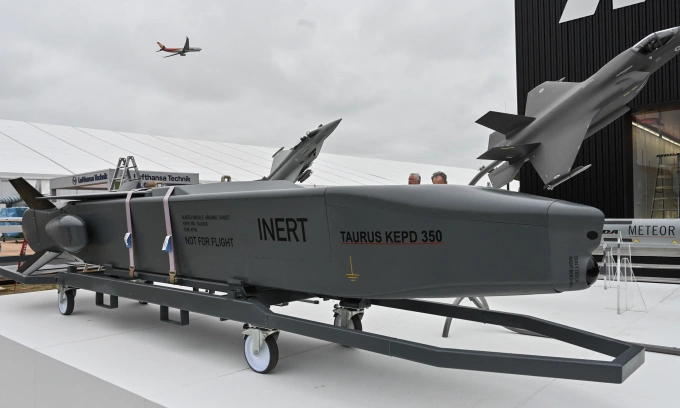
Why the West Lifted Long-Range Strike Limits on Ukraine
Western powers have officially dropped restrictions on Ukraine’s use of long-range weapons provided by allies—a move signaling a major policy shift designed to ramp up pressure on Russia and give Kyiv the tools it needs to strike back.
On May 26, German Chancellor Friedrich Merz confirmed that key Western allies—including Germany, France, the UK, and the U.S.—had lifted all restrictions on Ukraine’s use of Western-supplied long-range missiles, effectively giving Kyiv the green light to strike military targets inside Russian territory.
“This step was decided months ago,” Merz revealed. “I believe it’s necessary. You can’t defend yourself unless you can hit the enemy’s bases on their own soil.”
A Turning Point in the War
This decision marks a major inflection point in the Russia-Ukraine war and reflects a growing sense of urgency among Western governments. For years, Kyiv’s allies had imposed strict limits on how far Ukraine could strike with NATO-supplied weapons, in part to avoid provoking a direct conflict with Moscow. But evolving battlefield realities and shifting political dynamics have led to a rethink.
Political Drivers: Europe Steps Up
As the war drags on, pressure has mounted within the EU—not just from Ukraine but from shifting political winds across the continent. With U.S. President Donald Trump pushing an “America First” agenda and signaling a reduced commitment to Ukraine, European allies are increasingly expected to fill the void.
Russia’s recent escalation—launching the largest drone and missile attacks on Ukrainian cities since the war began—has only intensified Kyiv’s calls for Western support. President Volodymyr Zelensky has repeatedly urged NATO members to lift limits on long-range weapons, arguing that Ukraine’s inability to strike deep into Russian territory has placed it at a severe disadvantage.
“We are fighting with one hand tied behind our back,” Zelensky said, noting that Russia continues to bomb civilian infrastructure—hospitals, schools, power plants—without fear of reprisal.
Chancellor Merz’s government represents a more hawkish turn in Berlin’s foreign policy. Merz previously criticized former chancellor Olaf Scholz for blocking the transfer of German Taurus cruise missiles to Ukraine and threatened to escalate unless Russia ceased its large-scale assaults.
Since taking office in early May, Merz has emphasized coordination with NATO and European partners, signaling Germany’s intent to lead on defense while maintaining alliance unity.
With Trump openly questioning the long-term U.S. commitment to Ukraine, European leaders—particularly in Berlin, Paris, and London—have recognized the need to step up militarily.
Military Calculus: Shifting the Battlefield
On the ground, Ukraine continues to lose ground in key regions such as Pokrovsk, Kupiansk, and Kostyantynivka, while Russia reasserts control in the Kursk region and builds defensive buffer zones in Sumy.
Ukrainian forces have shown they can use NATO-provided systems like HIMARS, Storm Shadow, and ATACMS with precision. But prior restrictions meant they couldn’t strike deeper logistical or strategic assets inside Russia—such as air bases, ammunition depots, or command centers.
In response, Russia has moved critical military infrastructure further from the front lines, reducing the effectiveness of limited-range weapons. By removing range restrictions, Ukraine can now strike targets up to 300 km away with ATACMS or even farther with German Taurus missiles if they’re eventually provided.
According to Chancellor Merz, allowing such strikes is “a decisive change” that may alter the war’s trajectory. ISW analyst Riley Bailey agrees that, with a steady supply of long-range systems, Ukraine could cripple Russia’s logistical depth and strategic mobility.
Escalation Risks and Russian Warnings
The Kremlin responded furiously. Spokesperson Dmitry Peskov called the policy shift “highly dangerous,” accusing the West of abandoning peaceful solutions.
Both President Vladimir Putin and Foreign Ministry spokesperson Maria Zakharova warned that Ukraine cannot independently operate these complex systems—suggesting NATO’s involvement in targeting. They claimed the decision pushes the alliance into direct conflict.
Putin pledged to take “appropriate countermeasures,” raising concerns about escalation, including potential nuclear retaliation. Russia’s updated 2024 nuclear doctrine outlines a broader set of triggers for nuclear use—interpreted by analysts as a signal of heightened readiness.
Military commentator Col. Viktor Litovkin told Izvestia that the West’s decision contradicts its stated goal of peace while enabling Ukraine to strike deeper than ever before. “If Germany sends Taurus missiles, Ukraine could hit targets 500 km away,” he noted.
However, not all Russian experts believe the move is a game-changer.
Limited Impact?
Russian political scientist Alexander Konkov argued that while these new capabilities may offer Ukraine short-term tactical advantages, they’re unlikely to shift the overall balance of power—especially given limited supply and Russia’s ability to adapt.
Ukraine’s early use of ATACMS and Storm Shadow produced some tactical wins, but Moscow quickly moved key assets out of range. With Western missile stockpiles stretched thin, resupply remains a challenge.
“This may be more symbolic than strategic,” Konkov said. “Unless the West dramatically scales up deliveries, the battlefield impact could be limited.”
Moreover, this decision may further harden positions on both sides, making diplomatic compromise even more elusive. “With both Kyiv and Moscow showing little willingness to budge, and global tensions running high, a negotiated peace remains distant,” he added.
(Sources: RIA Novosti, Izvestia, Lenta)
Hello Shuttle will strive to bring the latest updates. At the end of the day.
Are you looking for reliable airport and cruise port transfer services in Los Angeles?
We offer professional, safe, and punctual transportation from
Los Angeles Airport - LAX
Long Beach Airport - LGB
John Wayne Airport - SNA
San Pedro cruise port
Long Beach cruise port
Disneyland
and other destinations.
Let us make your journey stress-free and comfortable with our dedicated drivers and high-quality vehicles. Book now for the perfect travel experience at www.helloshuttle.com or call 944-800-5678!


